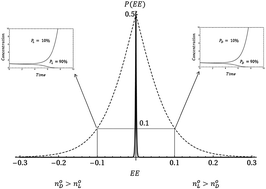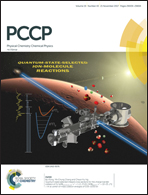Stochastic chiral symmetry breaking process besides the deterministic one†
Abstract
In chiral symmetry breaking, populations with initial enantiomeric excess (EE) are probabilistically favored if statistical fluctuation is present, as in nature. Stochastic methods correctly describe chiral symmetry breaking by taking into account the quantitative enantiomeric difference (excess or deficiency) and the statistical fluctuation amplitude, which is inversely proportional to the absolute size of the populations involved. From this, we obtain a law, which indicates that such a favoring probability decreases exponentially [P(EE) = 1/(eαEE + 1)] with an initial enantiomeric deficiency mediated by statistical fluctuation. Obviously, chiral symmetry breaking equally favors populations without enantiomeric excess [P(0) = 1/2]. However, if deterministic methods are considered, chiral symmetry breaking will strictly favor the population with an initial enantiomeric excess (EE). To study these stochastic chiral symmetry breaking processes the autocatalytic Frank model was considered. Summarizing, our results show that the initial enantiomeric excesses are not entirely responsible for the final state configuration of autocatalytic finite systems.



 Please wait while we load your content...
Please wait while we load your content...